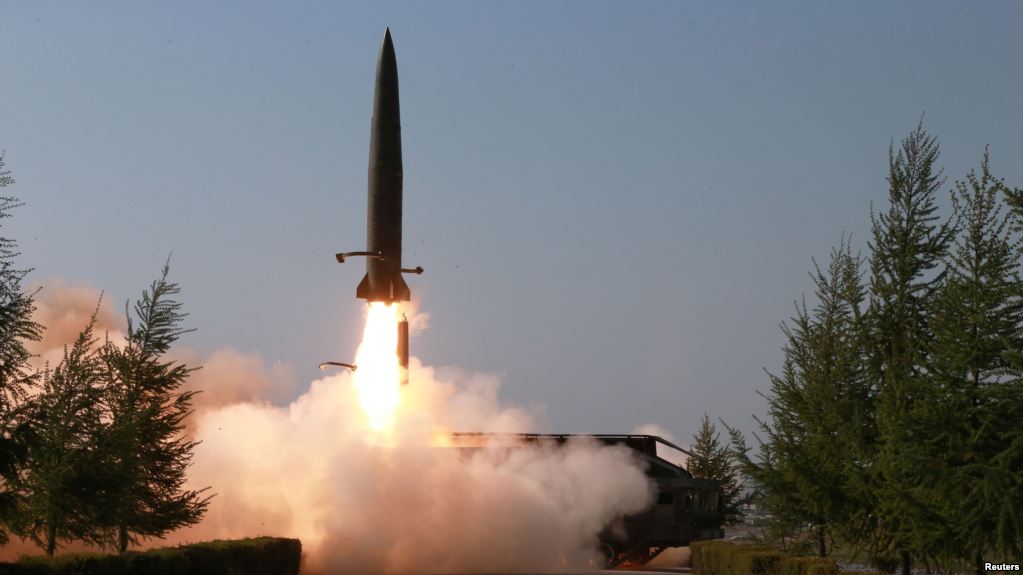TOKYO —
The three new missiles North Korean leader Kim Jong Un has tested over the past week are eerily familiar to military experts: They look just like a controversial and widely copied missile the Russian military has deployed to Syria and has been actively trying to sell abroad for years.
Ending a pause in ballistic missile launches that began in late 2017, and alarming North Korea’s neighbors, Kim personally supervised the launch of the first missile from the country’s east coast on Saturday and two more from the west on Thursday. All splashed down in the Pacific.
The missiles were short-range and the launches do not mean Kim has decided to end his self-imposed moratorium on testing long-range missiles that could reach the United States mainland. They do indicate, however, that Kim is methodically expanding the battle readiness of his missile forces and that could have a major impact on the safety of American allies and U.S. forces in the region.
The missiles bear a strong resemblance to the Russian-designed Iskander, a short-range, nuclear-capable ballistic missile that has been in the Russian arsenal for more than a decade.
“There are Russian technology fingerprints all over it,” said Marcus Schiller, a leading expert on North Korean missiles who is based in Germany.
He added that short of actually procuring the missiles from Russia, the North could have had key parts delivered from somewhere else, perhaps not directly from Russia, while making components such as the outer shell, or airframe, domestically.
The Iskander, or something like it, would be of particular interest to North Korea.
It’s designed to fly at a flattened-out altitude of around 40 kilometers (25 miles) and to make in-flight guidance adjustments. Both capabilities exploit weaknesses in the U.S. and South Korean missile defenses that are now in place, primarily Patriot missile batteries and the THAAD anti-missile defense system.
The Iskander is also quicker to launch, and thus harder to destroy on the ground, because of its solid fuel engine and more accurate because of its advanced guidance system.
Despite claims by senior members of the Trump administration that the missiles aren’t a threat to the United States, in a battle scenario they would likely be used to attack targets well behind the front-lines, such as the U.S. military bases in South Korea. There are roughly 28,000 U.S. troops stationed in South Korea and tens of thousands more family members and civilian Department of Defense employees.
The North first displayed a mock-up of an Iskander-like missile at a military parade in 2018. This week’s launches mark its first known flight tests.
Michael Elleman, director of the Nonproliferation and Nuclear Policy Program at the International Institute for Strategic Studies, said further analysis of the missiles’ performance will provide clues as to whether it was produced by Russia.
“If its flight path and accuracy were marginal or inconsistent with known Iskander trajectories and performance, then I think some form of local development with external technical assistance is more likely,” he said. “The key here is that one cannot make a new system without undertaking certain development steps. I have seen no evidence of such activity.”
Initial reports suggested at least one of the tests did involve an Iskander-like trajectory.
The Iskander missile system has been part of the Russian arsenal since 2006. The Iskander-M version used by the Russian military is more than 7 meters (yards) long, can weigh more than 4,000 kilograms (9,000 pounds) and has a range of about 400 to 500 kilometers (250 to 310 miles).
Russia first tested the Iskander in combat in 2008, against Georgia.
The Iskander missiles have long been a source of tension in Europe and were cited by President Donald Trump as a key reason behind his decision in February to break with the 1987 Intermediate-Range Nuclear Forces Treaty, which bans production, testing and deployment of land-based cruise and ballistic missiles with a range of 500 to 5,500 kilometers (310 to 3,410 miles).
Such missiles only take a few minutes to reach their targets, leaving no time for decision-makers and raising the likelihood of a global nuclear conflict over a false launch warning. Moscow claims the Iskander-M’s range is just below the operational limit and should not be considered a treaty violation.
From the start, Russia has seen the Iskander missile as a potential export.
To avoid running afoul of international non-proliferation restrictions, Russia produces a less-formidable version that has a reduced range and is designed to carry a smaller payload for sales abroad.
So far, it has sold that missile — called Iskander-E — to Algeria and Armenia. It has reportedly discussed exports to Iran, Libya, the United Arab Emirates, Malaysia and Saudi Arabia.
According to Siemon Wezeman, a senior researcher at the Stockholm International Peace Research Institute, which tracks the global arms trade, Russia has used the Iskander missile in Syria. He said Syria has expressed interest in buying its own Iskanders, but Russia has declined.
Wezeman stressed Russia cannot legally sell Iskanders of any variety to North Korea.
A United Nations embargo in place since 2006, when the North conducted its first nuclear test, prohibits supplying the North with major arms, including ground-to-ground missiles, and U.N. sanctions prohibit the transfer of ballistic missiles and related technology.
If North Korea is producing an Iskander clone, it would not be the first country to do so.
South Korea has what many believe is its own Iskander-inspired missile — the Hyunmoo-2. China also has a similar missile, called the DF-12 or M20 that was also configured with exports in mind. One of its buyers, Qatar, put them on display at a parade in 2017.
